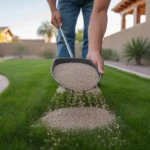As the weather warms up in Queen Creek, it’s time to turn your attention to your lawn. Spring is a critical season for getting your grass in top shape to withstand the brutal Arizona summer ahead. With some essential care and preparation now, you can ensure a lush, healthy yard that’s the envy of the neighborhood. Here’s what to focus on.

Give Your Lawn a Fresh Start
Begin by cleaning up any debris that accumulated over winter, such as leaves, twigs, and dead grass. Raking helps stimulate new growth and allows sunlight and water to reach the soil more easily. It also gives you a chance to assess your lawn’s condition and spot any bare or damaged areas that may need extra TLC.
If you have cool-season grass like ryegrass, now is the time to gradually lower your mower height to remove brown, dormant growth. For warm-season grasses like Bermuda that are just greening up, wait until it’s actively growing before mowing. In both cases, never remove more than ⅓ of the grass blade height at a time to avoid stressing the turf.
Tackle Weeds Early
Spring is prime time for weed seeds to sprout in Queen Creek lawns. Catching them early, before they have a chance to establish deep roots, is key. Hand-pull any visible weeds or spot-treat with a selective post-emergent herbicide that won’t harm your grass type.
For even better control, consider applying a pre-emergent weed preventer in early spring, timed just before your lawn fully greens up. This creates a barrier that stops many common weeds from germinating in the first place. Be sure to water it in thoroughly for best results.
Feed for Optimal Growth
Once your grass is actively growing, usually by April in Queen Creek, it’s time for spring fertilization. Choose a balanced, slow-release fertilizer formulated for your grass type. This provides a steady nutrient supply over 6-8 weeks, fueling thick, lush growth.
If you have Bermuda grass, an additional application of nitrogen-rich fertilizer in late spring can give it an extra boost before summer heat arrives. Avoid fertilizing dormant grass, as it can’t uptake nutrients effectively. Always follow package instructions and water deeply after applying to move nutrients to the roots.
Adjust Watering for the Season
As temperatures rise and spring rains taper off, your Queen Creek lawn will need more moisture to thrive. Gradually increase watering frequency and duration to supply about 1 inch per week, or more during hot, dry, or windy periods.
Water deeply and infrequently to encourage deeper roots and improved drought tolerance. Aim to moisten the top 6-8 inches of soil, then let it dry slightly between waterings to avoid soggy conditions. Early morning is the best time to irrigate, allowing grass to dry before nightfall.
Aerate and Dethatch as Needed
If your Queen Creek lawn struggles with compacted soil or heavy thatch buildup, spring is an ideal time to address these issues. Aerating, or removing small soil cores, alleviates compaction and allows water, air, and nutrients to penetrate the root zone more easily. This is especially beneficial for high-traffic or clay soil areas.
Dethatching removes the thick layer of dead grass stems that can block moisture and nutrients if it exceeds ½ inch. Use a power rake or vertical mower to slice through the thatch, then remove the debris. Both aerating and dethatching are stressful for grass, so tackle them in early spring while the lawn is actively growing but before summer heat hits.
By checking off these spring care tasks, you’ll be rewarded with a Queen Creek yard that’s lush, resilient, and ready for the season ahead. Consistency is key, so make lawn maintenance a regular habit to keep your grass thriving all year long.











